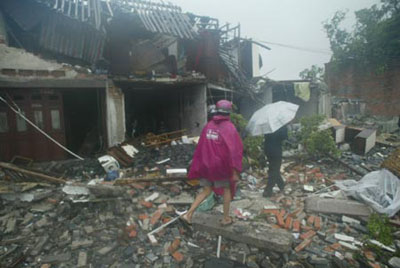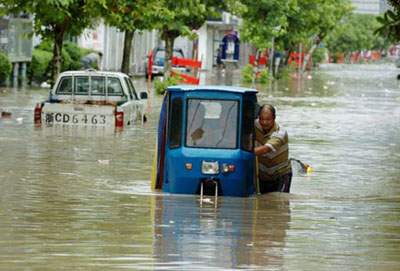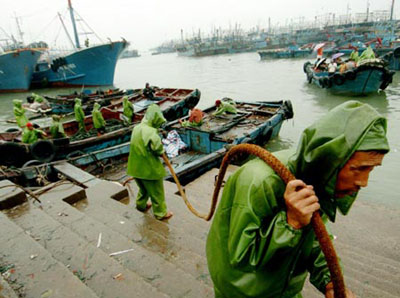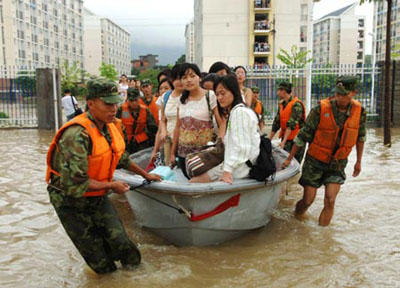| Home / Environment / News | Tools: Save | Print | E-mail | Most Read |
| Sepat Wreaks Havoc, Kills 15 |
| Adjust font size: |
At least 15 people were killed on China's mainland in the past two days as Typhoon Sepat spawned a tornado in eastern Zhejiang Province before landing in the neighboring province of Fujian yesterday morning. Severe weather conditions also necessitated the evacuation of more than 900,000 people as a precaution.
Chinese villagers walk through the rubble of houses after typhoon Sepat in Cangnan, east China's Zhejiang Province, August 19,2007. Zhejiang bore the brunt of the typhoon when a tornado swept Longgang Town, Cangnan County, just before midnight on Saturday. Zhejiang authorities yesterday confirmed that 13 people were killed in landslides and home collapses as the tornado tore through the city. Another 60 were injured, according to the China News Service. Six of the injured were listed in serious condition, the agency said, citing the provincial flood headquarters. The dead included a man in his 40s who was killed when the van in which he was riding was knocked off the road by a landslide. Eighteen others in the van survived.
A man pushes his tricycle through a flooded street after the typhoon Sepat in Wenzhou, east China's Zhejiang Province, August 19, 2007. As of yesterday afternoon, the severe weather had disrupted the life of nearly two million residents in the cities of Lishui, Taizhou and Wenzhou, which administers Cangnan, in Zhejiang, the report said. Meanwhile, the tornado toppled more than 1,100 homes, damaged 22,700 hectares of crops and 800 hectares of fish farms across the province. Floodwater and landslides triggered by rain also damaged more than 370 kilometers of highways and about 340 kilometers of power lines, local authorities said. Levees broke at nearly 200 sites, totaling about 22 kilometers, they added. Across the province, Mother Nature's rage also suspended operations at more than 2,100 factories and plants. Zhejiang officials put the immediate economic losses from the weather at an estimated 840 million yuan (US$111 million).
Chinese fishermen arrange the boats after the typhoon Sepat in Quanzhou, east China's Fujian Province, August 19, 2007. Sepat, named after a Malaysian freshwater fish, landed in Chongwu Town, Hui'an County of Fujian's Quanzhou City, at 2 AM yesterday. Fujian officials said a landslide killed two people and left another one missing yesterday. The storm lashed the central and northern parts of Fujian with gale force winds and heavy rain. Within a 24-hour period that lasted up to 8 AM yesterday, rainfall topped 300 millimeters in two areas of Fujian and 200 millimeters in 11 counties and cities. Fujian has 95 counties, cities and prefectures. The typhoon damaged 366 houses in Quanzhou, inundated 5,920 hectares of crops, and cut off road traffic and power supply lines, affecting 162,600 people and inflicting an economic loss of 72 million yuan, local authorities said.
Chinese soldiers evacuate university students from a flooded campus in Fuzhou, east China's Fujian Province, August 19, 2007. Some 2,500 students from Fuzhou University were transferred to safe areas after their campus was submerged and the electricity was cut off for one day due to the typhoon Sepat. Heavy rains caused by Sepat also led to a train station collapsing west of Fuzhou, Fujian's capital, causing the derailment of six carriages of a cargo train. Some air traffic was halted in Fujian but resumed later yesterday, Fujian authorities said. Sepat late yesterday morning weakened to a strong tropical storm. It moved northwest and is expected to enter Fujian's neighboring Jiangxi Province this morning. (Shanghai Daily August 20, 2007) |
| Tools: Save | Print | E-mail | Most Read |
 |
| Related Stories |
|
||||




